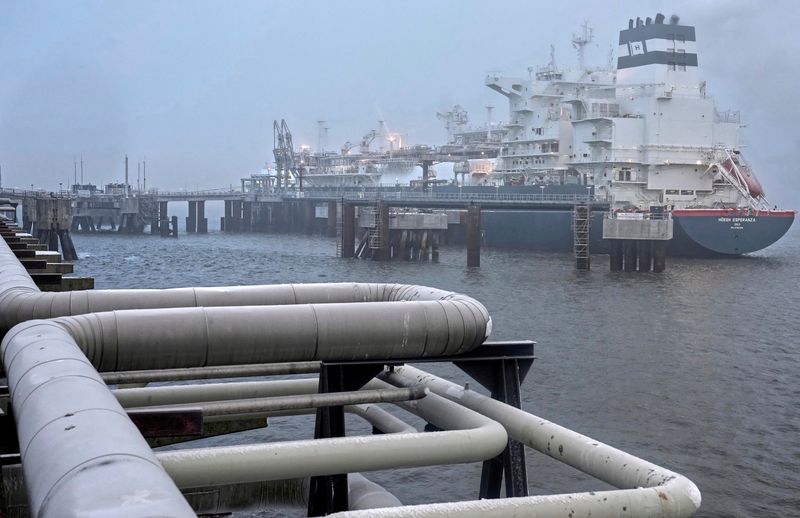By Vera Eckert
WILHELMSHAVEN, Germany (Reuters) - Germany's only deep water port, home to its largest naval base, is where energy firms now plan to spend more than $5.5 billion to help construct the clean energy infrastructure the country needs to help end its reliance on Russian gas.
Europe's leading industrial exporter has only just managed to get through an energy crunch by rushing to build makeshift floating infrastructure for importing liquefied natural gas (LNG), aiming to partially plug the gap left by Moscow's cuts.
But with energy firms already looking beyond LNG in efforts to reduce fossil fuel use, the port of Wilhelmshaven on Germany's northern coast is emerging as a hub for the infrastructure which is needed for hydrogen and ammonia imports, hydrogen production and offshore carbon emissions storage.
"We will become the pumping heart of Germany by 2030," said Alexander Leonhardt, who heads the business development agency for Wilhelmshaven, which has a population of 80,000. Challenges to its development include concerns about disturbing wildlife in the sensitive Wadden Sea and the risks of LNG overcapacity.
Uwe Oppitz of Rhenus Ports, who speaks for Energy Hub Port Wilhelmshaven, said that Wintershall Dea, Uniper and Tree Energy Solutions (TES) plan to spend a total of more than 5 billion euros at Wilhelmshaven.
Energy Hub Port Wilhelmshaven comprises 30 companies, which include E.ON, RWE and Orsted (OTC:DOGEF), as well as Wilhelmshaven's home state of Lower Saxony.
Oppitz said the investment, the magnitude of which has not previously been reported, will be made between 2026 and 2030, adding that the overall figure was disclosed on condition that no breakdown would be published.
TES, which is backed by Belgium private investment firm AtlasInvest, said the total sum was plausible.
Wintershall Dea said it is planning two projects, called BlueHyNow and CO2nnectNow.
"Feasibility studies are currently being prepared for both projects, which will provide further insights into their practicability," the company said in an emailed comment.
"Wintershall Dea plans to invest around 1 billion euros in the Wilhelmshaven site together with its partners," it said.
Uniper was not immediately available for comment.
The investment commitment is raising hopes that money and jobs can be funnelled into what is a relatively weak region economically and that it may even attract some companies to relocate from Germany's industrial heartland in the south.
Planned investments include electrolysis plants that could be scaled up to more than 1 gigawatts (GW) size, Oppitz said.
Wilhelmshaven is not only the landing point for pipelines and vessels, it has a flourishing offshore wind presence and gas storage caverns, while rail links from legacy activities are also a potential draw for new investment.
(Graphic: Port of entry - https://www.reuters.com/graphics/GERMANY-ENERGY/zgpobjmbmvd/chart.png)
GREEN HYDROGEN RUSH
Already home to Germany's first floating LNG terminal (FSRU), which is operated by state-controlled Uniper, Wilhelmshaven is also where TES is due to bring another FSRU into service by the end of this year.
Both companies are planning for clean gas production to begin in the second half of this decade.
And while Wintershall Dea will not get involved in LNG, it wants to repurpose some Norwegian pipeline gas imports for hydrogen production, capturing carbon dioxide from the process and exporting it in liquefied form for permanent subsea storage.
Wilhelmshaven's mayor Carsten Feist said he expects to create 1,000-2,000 jobs over the next five years and double corporate tax revenue, if such plans proceed.
To lessen their bills, the companies will tap funds under the European Union's Projects of Common Interest funding (PCI) scheme, hoping for grants to the tune of 30-50%, said Oppitz.
TES said it is confident no subsidies will be needed for its projects.
Paper maker PKV, a big employer 13 kilometres south of Wilhelmshaven, plans a new factory that working with the port projects could perhaps use waste heat from planned electrolysis plants that produce green hydrogen from renewable electricity.
And steelmaker Salzgitter has already struck a deal with Uniper to receive green hydrogen for its steel mill processes, replacing essential fossil-fuel produced hydrogen.
Oppitz said that other firms are assessing the opportunities Wilhelmshaven offers, with clean hydrogen primarily needed by refineries, chemicals, fertilisers and metals makers while industry might welcome carbon storage options.
The Wilhelmshaven business promotion agency estimates that the region could produce more than 30 terawatt hours (TWh) of hydrogen a year from 2030. This alone would represent a quarter of Germany's demand for green hydrogen at that date, namely 95-130 TWh, according to its national hydrogen strategy.
Wintershall Dea wants to grow with that market, said project leader Andreas Moeller.
He rejected suggestions that carbon capture and storage (CCS) strategies are simply a way for fossil fuels to survive.
"We don't want to push green hydrogen to the side. On the contrary, we want to support its ramp-up," he said.
Gundolf Schweppe, chief executive of Uniper Energy Sales said it plans to bring up to 2.6 million tonnes of green ammonia into Wilhelmshaven a year in the second half of this decade.
That is not far off Germany's current production of ammonia, a fertiliser raw material, of 3 million tonnes a year.

Meanwhile, TES wants to bring renewable methane under the name electric natural gas (e-NG) from solar power made overseas into Wilhelmshaven from 2027.
($1 = 0.9129 euros)